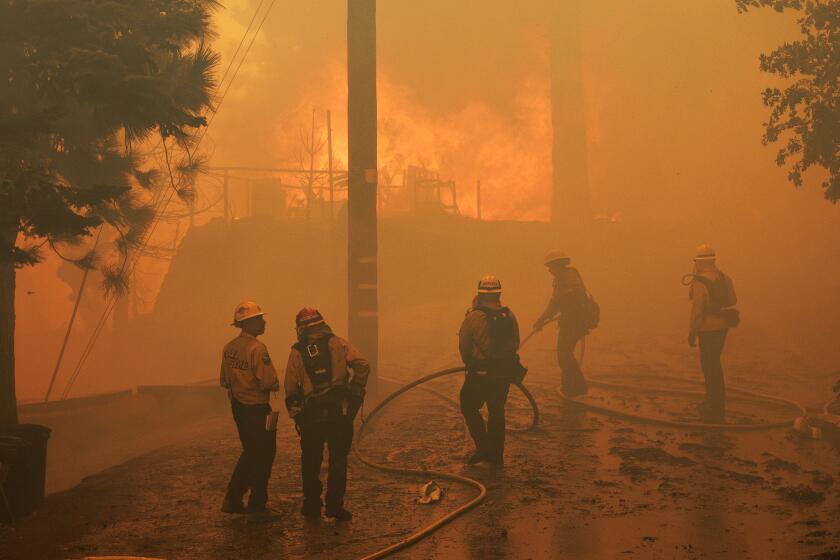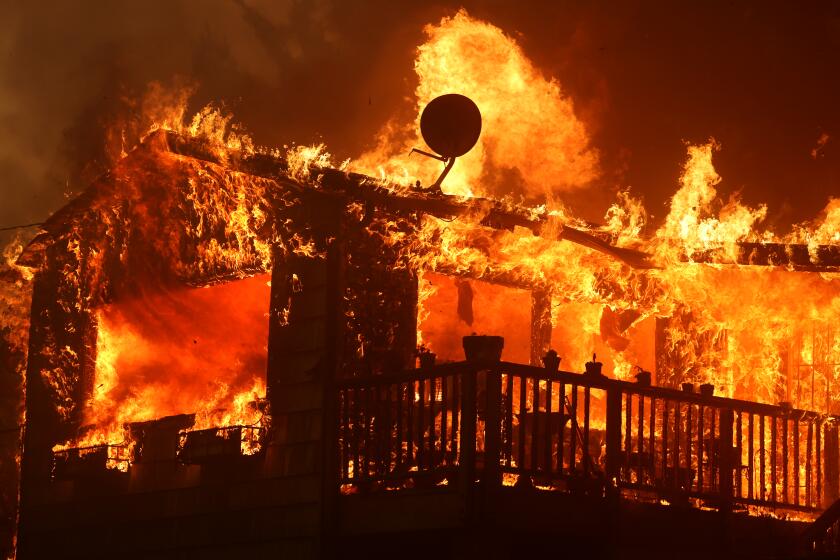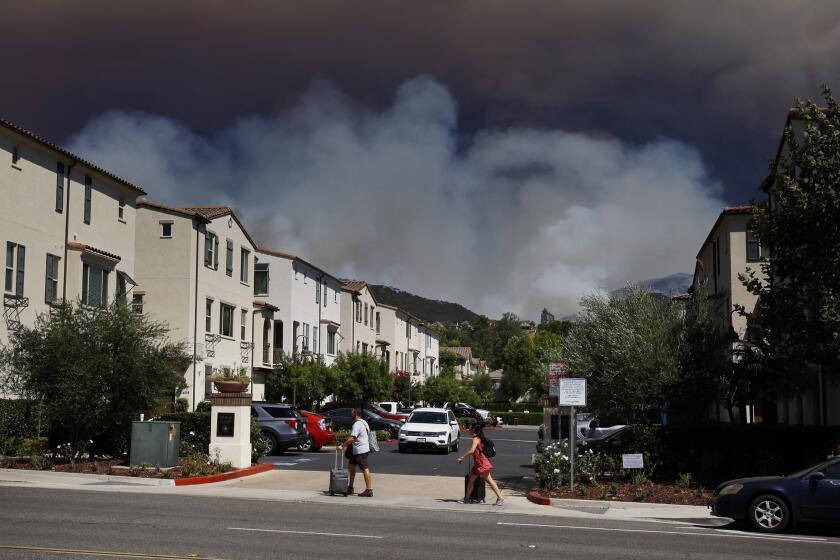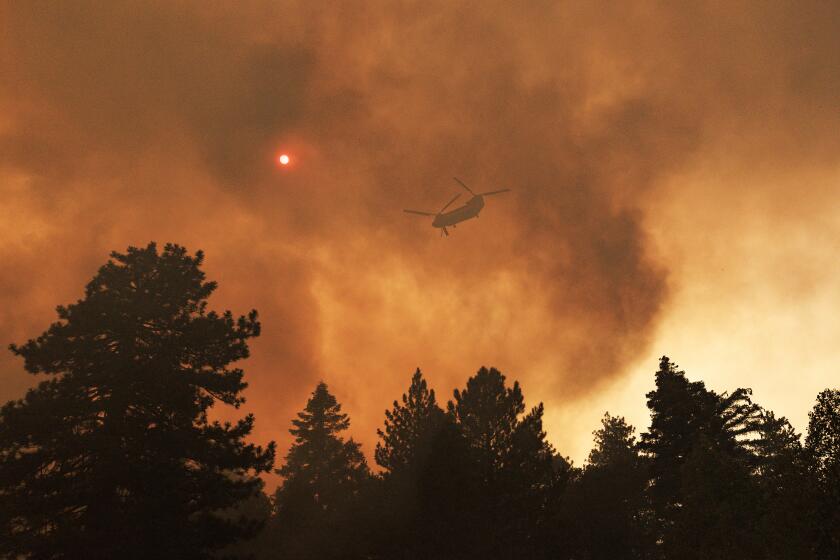SoCal fires burn 100,000 acres, destroy dozens of homes and injure 13

- Share via
Three fast-moving wildfires have burned homes, caused injuries and scorched more than 100,000 acres across Southern California in a matter of days, prompting a state of emergency as firefighting crews attempt to assess damage and gain control over the blazes.
The largest of the three, the Bridge fire, broke out Sunday in Angeles National Forest and exploded from 4,000 acres to more than 50,000 acres between Tuesday and Wednesday evening.
Fueled by bone-dry brush and days of extreme heat and winds, the fire prompted evacuations in a number of mountain hamlets, towns and resorts along Highway 2, with towering flames jumping across hillsides and canyons. Twenty homes have been destroyed in Mount Baldy, 13 homes in Wrightwood and six cabins in the wilderness area. About 2,500 structures are threatened by the fire, officials said.
An overview of evacuation orders, shelter options, mental health resources, donation info and more for the Airport, Bridge and Line fires in Southern California.
“This is currently the largest active fire in the state of California,” L.A. County Fire Chief Anthony Marrone said during a news conference. “Our priority remains the protection of life and structure and infrastructure defense.”
In the two other major Southern California fires — the Airport fire and the Line fire — at least 13 people, including several firefighters, have been injured. The Airport fire had charred more than 20,000 acres in Riverside and Orange counties, and the Line fire in San Bernardino County had burned more than 36,000 acres and was 18% contained.

Officials have not determined what sparked the Bridge fire. The Airport fire was started unintentionally by a spark from heavy equipment moving rocks in the Trabuco Canyon foothills, and authorities said the Line fire was arson.
Gov. Gavin Newsom declared a state of emergency Wednesday night for the three fires.
Meanwhile, another brush fire cropped up about 60 miles northwest of the Bridge fire Wednesday morning at the north perimeter of the Angeles National Forest in Palmdale. The Joshua fire had spread to 30 acres as of Wednesday afternoon, burning along Mt. Emma Road with 0% containment.
After a heat wave struck Southern California, fires erupt across the Southland, burning hundreds of thousands of acres while threatening homes.
It’s the large blazes burning in the Southland that are being prioritized, with fire officials working to move resources from smaller area blazes while tapping out-of-state crews to fight the fires — but a record-setting fire season across the West has created a nationwide shortage of firefighters, aircraft and contractors to fight these blazes.
Oregon, Idaho and Washington are dealing with hundreds of fires resulting from multiple weeks of dry lightning strikes on parched vegetation.
“Yes, there is a strain on resources,” said Adrienne Freeman, a spokesperson for the U.S. Forest Service. “We had multiple fires start in close succession, all with critical numbers of affected people in huge urban centers.”
The National Interagency Fire Center has set the current national preparedness level to 5 — the highest possible — indicating that federal resources are fully committed and the potential for significant wildland fires to emerge is expected to remain high across multiple geographic areas. That level has been reached this early in the year only four times in the last two decades, according to the agency.
On Wednesday, the north and east flanks of the Bridge fire were expected to continue to grow, threatening Wrightwood and the Pinon Hills community. Firefighters were able to hold the fire on the west side of Mount Baldy Road, allowing crews to get in and defend the community, said Lisa Cox, a spokesperson for the California Interagency Management Team on the fire.
Higher humidity levels are expected in the coming days, “which is really good news because it’s going to aid the firefighters in holding the lines they’ve constructed” and help them protect cities south of the fire including Upland, Cox said.
Dramatic video in Wrightwood shows homes being consumed by flames late Tuesday as fire crews rushed to protect structures in the mountain community. Burning embers cascaded over the state highway as flames rose on both sides of the road.
Although the inferno reached Mountain High Resort, the popular ski spot did not sustain severe damage. The resort staff turned on snowmakers in an effort to keep the flames at bay.
“Fire raced through the area yesterday but all the main lifts and buildings survived with little to no damage,” the resort wrote on social media. “Thank you to all the employees and firefighters for their hard work. Our hearts go out to the Wrightwood families that may be suffering. We are with you!”
Some O.C. communities are under evacuation orders due to the Airport fire, but many residents are staying for now, hoping firefighters can keep the flames away from their neighborhoods.
The afternoon sky was dark with smoke Tuesday when Michelle Speers fled her home in Wrightwood. This isn’t the first evacuation Speers has experienced, but this blaze carried a real sense of danger, she said.
Emergency vehicles drove into her neighborhood with screaming sirens and loudspeakers, ordering people to leave. The family rushed to grab belongings.
Speers’ 6-year-old and 2-year-old granddaughters gathered their blankets, tablets, shoes and clothes. Speers grabbed an emergency box of all the important family documents, her laptop, jewelry, a day planner and some clothes. The road was packed as she drove away from her home, and she couldn’t help but think of the deadly 2018 Camp fire in Paradise, Calif., where fleeing residents were caught in bumper-to-bumper traffic as the flames surrounded them.
“The red embers rained down on us, bits of timber, as we were loading the car up to leave,” Speers said from a family member’s home in Glendale. “It was so scary.”
Many were hesitant to leave their homes despite the rapidly advancing blaze, said Los Angeles County Fire Deputy Chief Mike Inman.
“They never believed it would happen but then they believed it when they saw it come to town,” he said.

On Wednesday morning, a dense layer of smoke continued to choke the mountain community. A steady stream of ash rained down on firefighters stationed in the area.
Gusty winds, combined with warm temperatures, created favorable conditions for the Bridge fire to explode overnight. Low humidity also contributed to the spread of the fire, National Weather Service meteorologist Ariel Cohen said.
The past two wet winters have created a significant amount of brush, meaning there’s a lot more fuel susceptible to burning, Cohen said.
“It’s a really energetic phenomenon,” she said.
Three people — two civilians and one off-duty sergeant — will need to be rescued by air from a remote area five miles west of Mount Baldy on Wednesday, but officials are waiting until the smoke clears. The civilians were recreating in the area during the time of the fire and got caught in the blaze. None are injured, said L.A. County Sheriff Robert Luna.
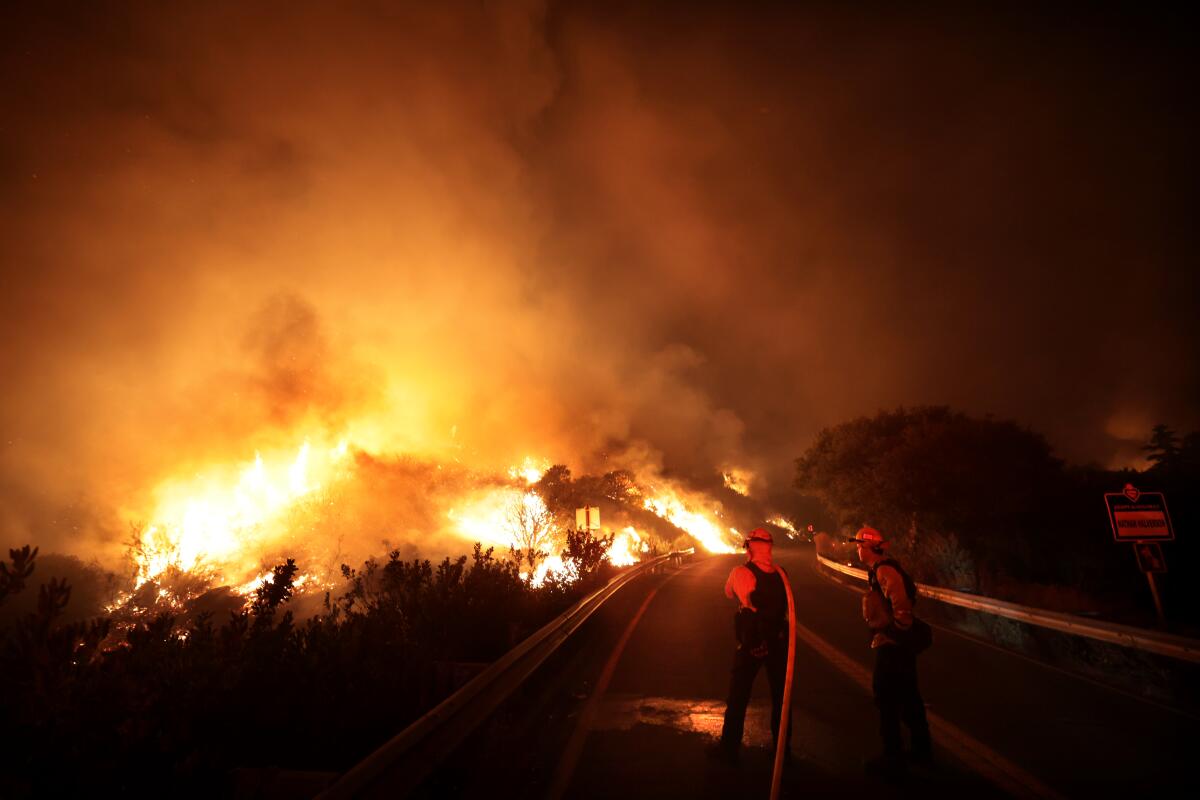
Farther south of the Bridge fire, the Airport fire roared up the Santa Ana Mountains in Orange County and was headed downhill toward Lake Elsinore, spurring evacuations. Some homes burned along Ortega Highway in the Decker Canyon area, but authorities could not provide a specific number.
The Airport fire has grown to 22,376 acres and was 0% contained Wednesday afternoon. The fire ignited Monday afternoon amid the stubborn heat wave that fueled fires across the region.
Gov. Gavin Newsom announced Wednesday that the state had secured grants from the Federal Emergency Management Agency to help provide resources to L.A., San Bernardino and Riverside counties to assist with the costs of suppressing the current brutal fires.
“California is continuing to see extreme fire behavior across multiple locations in Southern California, where hot, dry weather has led to rapid fire growth,” Newsom said. “We are thankful for federal support from the Biden-Harris administration to support firefighters as they work to suppress these fires and keep people safe.”
A Norco man has been arrested on suspicion of igniting the destructive Line fire, which has burned tens of thousands of acres in San Bernardino County.
Eight firefighters and two civilians were injured and sent to hospitals for treatment Monday and Tuesday as a result of the Airport fire, Orange County Fire Authority Capt. Sean Doran told The Times. Two of the victims sustained burns.
The agency did not provide information on the status of the patients or the severity of their injuries.
More than 5,000 homes are under evacuation orders in Riverside County, affecting more than 19,000 residents, California Department of Forestry and Fire Protection Division Chief Todd Hopkins said at a Wednesday news conference.
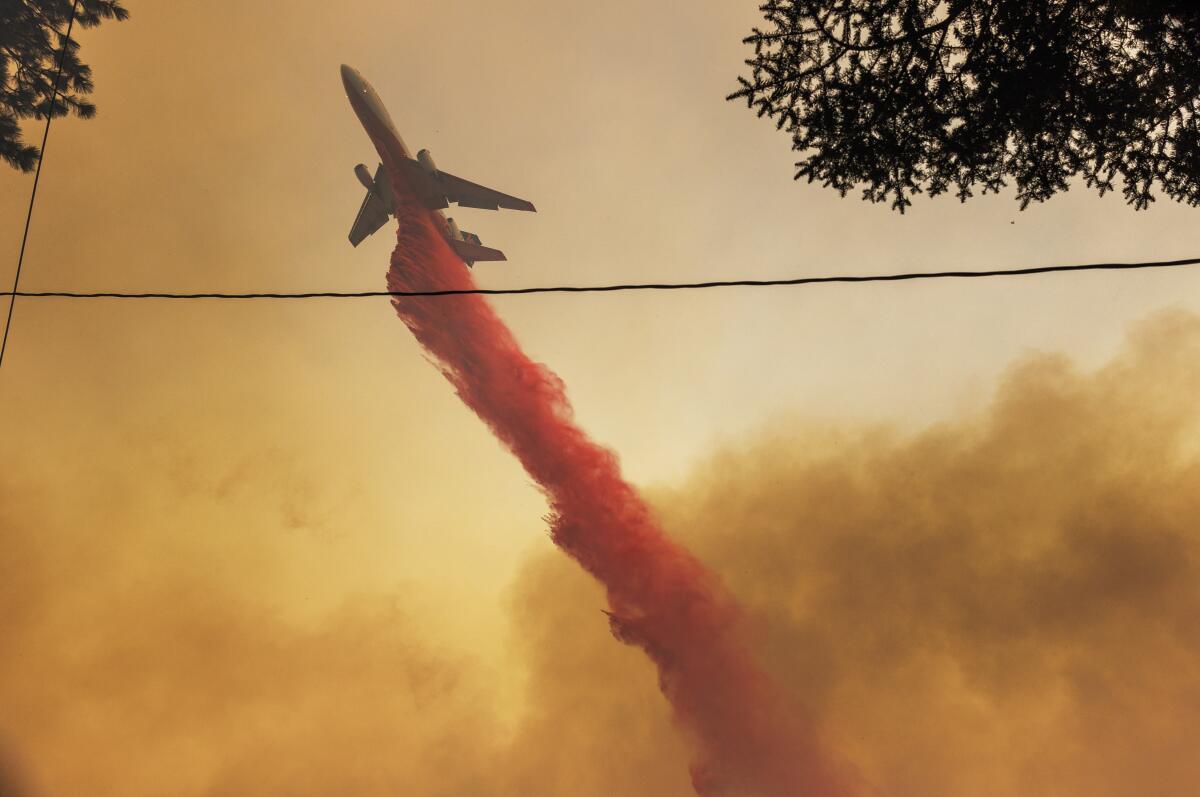
The Line fire in San Bernardino County began Thursday and had scorched 34,729 acres with 14% containment Wednesday afternoon. Evacuations were in place for several communities southwest of the fire, which was expected to continue to grow throughout the day amid dry conditions and strong winds, according to fire officials.
On Tuesday, Justin Wayne Halstenberg, 34, was arrested on suspicion of arson in connection with the Line fire. San Bernardino County sheriff’s officials said they discovered evidence inside Halstenberg’s residence and vehicle that supported his arrest. They did not specify what evidence they found or how they identified Halstenberg as a suspect. The Norco resident is being held in lieu of $80,000 bail.
“It’s my belief that as time goes on and we allow them to do the critical work that they’re doing, that we will actually find out the suspect may be responsible for other fires,” San Bernardino County Sheriff Shannon Dicus said at a news conference Tuesday.
More than 65,000 structures are threatened in the blaze, but fire officials have not confirmed whether any property has been damaged. At least one home went up in flames on Pine Cone Drive in Running Springs, according to a Times photographer.
Cal Fire spokesman Robert Foxworthy said that fire crews were so far managing with the resources they had and that the year had not yet reached the level of 2020, when more than 4.3 million acres burned across California. But they were preparing for a potentially active season ahead.
“The three fires that we have going are large and taking on a lot of resources, but this is not at all the worst that California has experienced, and we’ve dealt with much larger, busier fire seasons in the past,” he said. “So I feel very confident that we’re going to be able to meet the need as we move into the fall.”
Staff writers Ashley Ahn and Hayley Smith contributed to this report.
More to Read
Sign up for Essential California
The most important California stories and recommendations in your inbox every morning.
You may occasionally receive promotional content from the Los Angeles Times.
